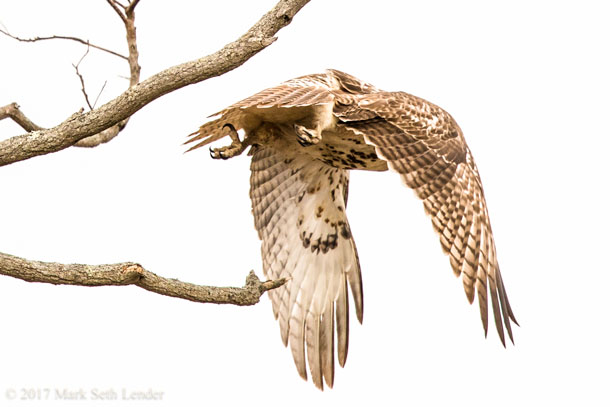Field Note: Red-Tailed Hunter
Published: November 2, 2018
By Mark Seth Lender

A red-tailed hawk heads out for the hunt. (Photo: Mark Seth Lender)
Living on Earth’s Explorer-in-Residence Mark Seth Lender shares this field note with his thoughts on the predatory habits and special adaptations that make a Red-Tailed hawk a skilled and stealthy hunter.
Beginning in October, all along the shoreline of Southern New England, the presence of Red-Tailed hawks increases. You see them coasting from cover to cover, perched above marsh lands, appearing, disappearing into the fall colors of birches and maple, and hickory.
As the leaves fall, and the cold of winter settles in, Red-Tails give themselves away. After the chill of night they are greedy even for the scant heat of sunrise. If they turned their dark backs to the sun instead of that nearly white breast it would be harder. But their backs are cloaked by wings that keep the heat out of the core. The breast is not.
Why then isn’t the breast dark also? They would certainly absorb more thermal energy. The reason is, a bird that is light from below is harder to see. That light breast means prey are less likely to detect a soaring Red-Tail, unless the shadow passes directly over them. Apparently, to the Red-Tail, camouflage matters more from a survival standpoint than keeping warm.
When Red-Tails perch camouflage is not their concern. Then they prefer an unobstructed view. A dead limb. The high point of a juniper. Or better yet, the top of a telephone pole from which Red-Tail only has to spread her wings to take flight. Seeing means being seen, so that the favorite strategy of close ambush is out of the question. Instead the target must be at some distance -- a mouse in a field perhaps --and then the killer is not seen until it is too late.
I think the purpose of a high plain perch is as much defense as offense. Most hawks (and eagles too) will choose similar resting places. If you find a spot frequented by Red-Tails, it is likely that over time, you will find other hunters using it as well. You cannot sneak up on a bird of prey with a 360 degree view and consequently, for the birds of prey clerestory feels like safety.
Except from us.
For some time there was a Red-Tailed Hawk nailed to a pole near on the Metro North line into New York. There were chickens in an enclosure beside the tracks and the owner killed her and left her there as a warning.
Back to Mark Seth Lender Field Notes
Living on Earth wants to hear from you!
Living on Earth
62 Calef Highway, Suite 212
Lee, NH 03861
Telephone: 617-287-4121
E-mail: comments@loe.org
Newsletter [Click here]
Donate to Living on Earth!
Living on Earth is an independent media program and relies entirely on contributions from listeners and institutions supporting public service. Please donate now to preserve an independent environmental voice.
NewsletterLiving on Earth offers a weekly delivery of the show's rundown to your mailbox. Sign up for our newsletter today!
 Sailors For The Sea: Be the change you want to sea.
Sailors For The Sea: Be the change you want to sea.
 The Grantham Foundation for the Protection of the Environment: Committed to protecting and improving the health of the global environment.
The Grantham Foundation for the Protection of the Environment: Committed to protecting and improving the health of the global environment.
 Contribute to Living on Earth and receive, as our gift to you, an archival print of one of Mark Seth Lender's extraordinary wildlife photographs. Follow the link to see Mark's current collection of photographs.
Contribute to Living on Earth and receive, as our gift to you, an archival print of one of Mark Seth Lender's extraordinary wildlife photographs. Follow the link to see Mark's current collection of photographs.
 Buy a signed copy of Mark Seth Lender's book Smeagull the Seagull & support Living on Earth
Buy a signed copy of Mark Seth Lender's book Smeagull the Seagull & support Living on Earth

